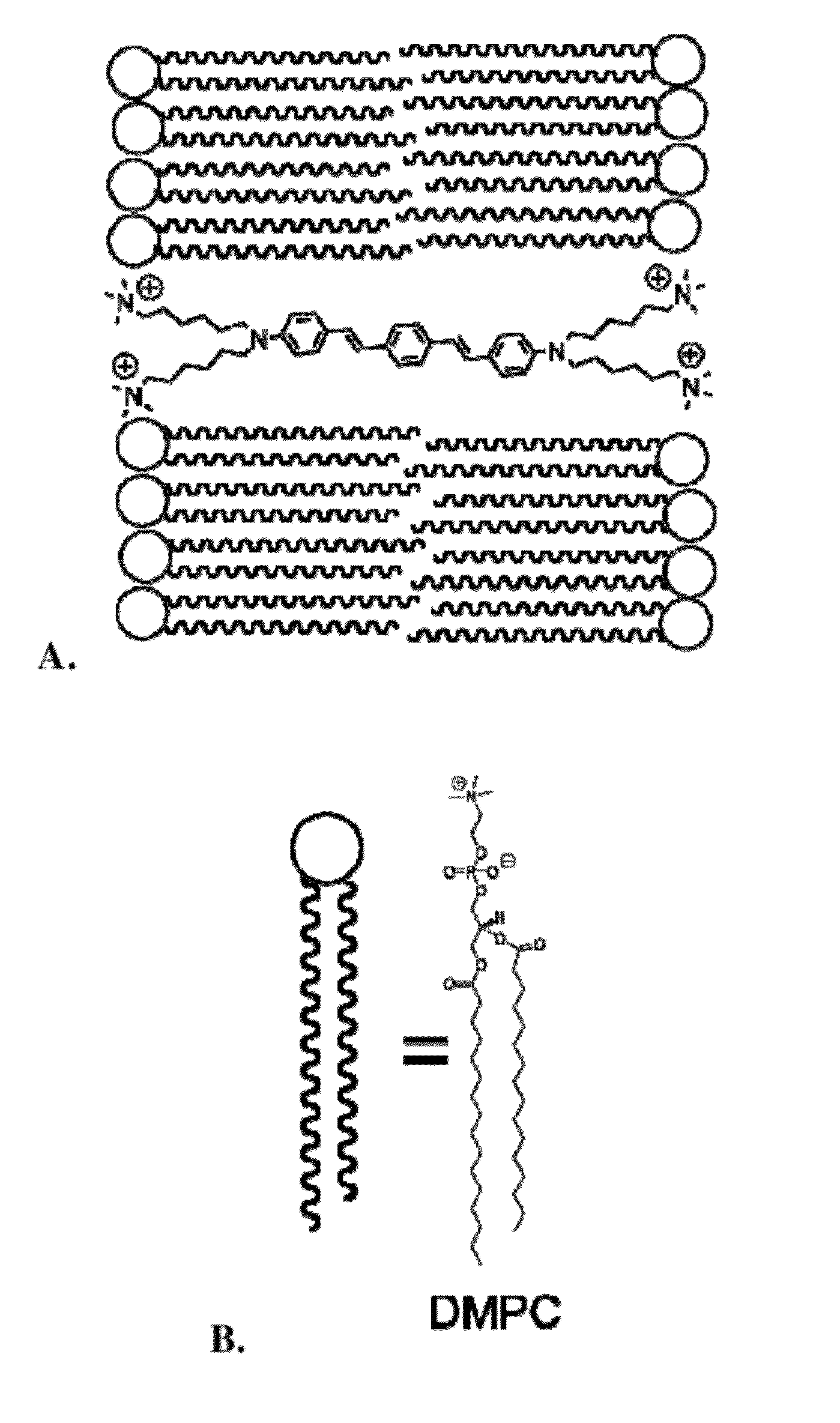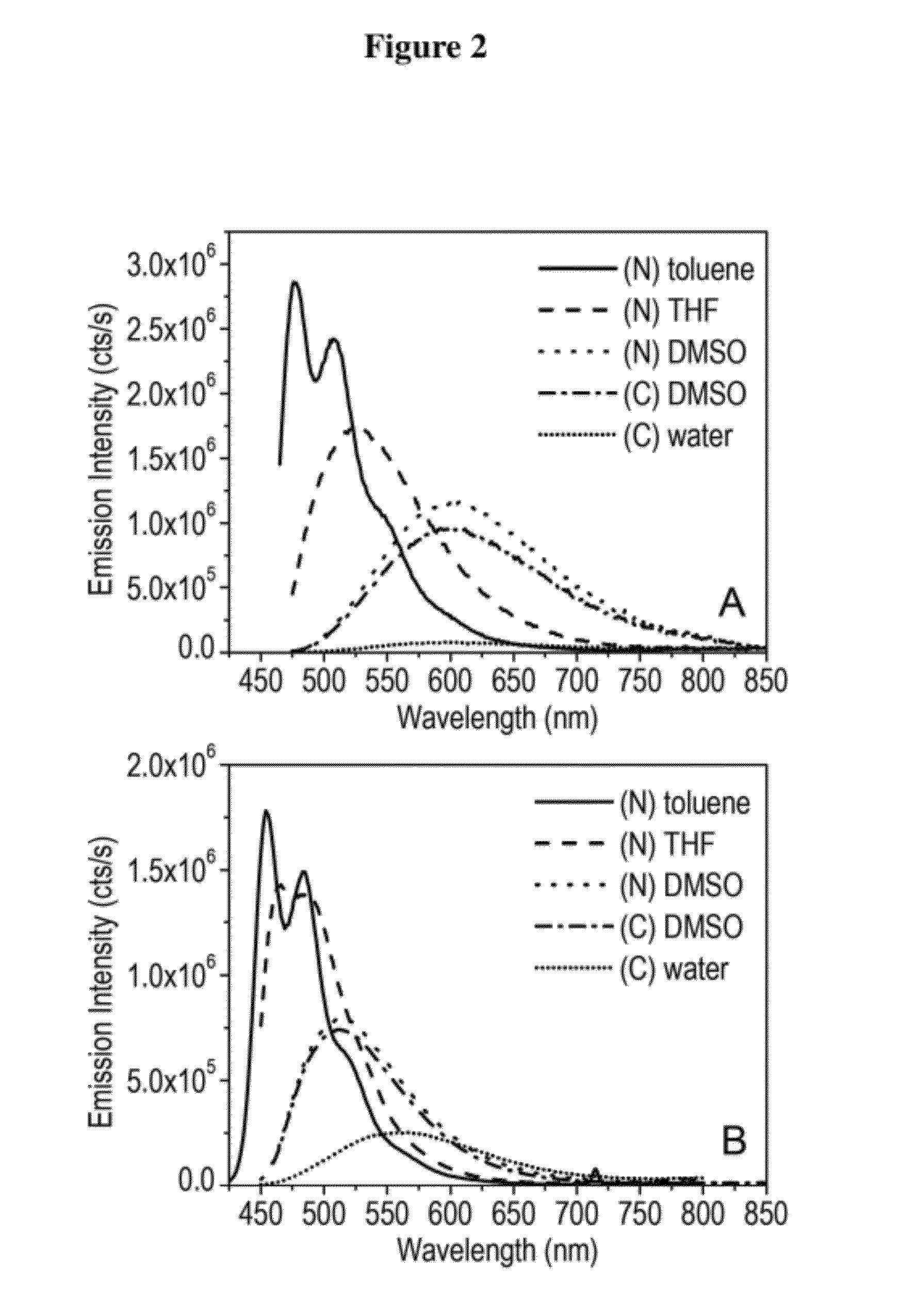Agents for enhanced charge transport across microbial membranes
a technology of microbial membranes and agents, applied in the field of agents for enhanced charge transport across microbial membranes, can solve the problems of limiting the kinetics of the reaction, constraining the voltage generated, and requiring improvements in the performance of mfcs, and achieve the effect of enhancing the performance of a microbial fuel cell
- Summary
- Abstract
- Description
- Claims
- Application Information
AI Technical Summary
Benefits of technology
Problems solved by technology
Method used
Image
Examples
example 1a
Preparation of (E)-1,2-bis(4-(chloromethyl)phenyl)ethene (2B)
[0129]A 100 mL 2-neck Schlenk flask was interfaced with a reflux condenser, placed under an inert atmosphere, and flame dried. This flask was charged with 50 mL of dried, degassed CH2Cl2 via cannula. In a glove box under nitrogen 40 mg of 2nd generation Grubbs catalyst (1 mole % of 1 eq., 47 μmol) was sealed in a 25 mL Schlenk flask and removed from the glove box. This flask was interfaced with a Schlenk manifold and 20 mL of dry, degassed CH2Cl2 was added to the flask via cannula, yielding a dark red solution. This solution was then cannulated into the 100 mL reaction apparatus. A syringe was then used to load the reaction flask with 1.34 mL (2 eq., 4.7 mmol) of dry vinylbenzyl chloride. The solution was allowed to reflux under Ar at 50° C. for 24 hours. The reaction solution was then allowed to cool slowly and sit for ˜2 hours. The product crystallized out of the reaction solution and the crude (off-white needle crystals...
example 1b
Preparation of (E)-4,4′-bis(diethylphosphonatemethyl)stilbene (E)-tetraethyl (4,4′-(ethene-1,2-diyl)bis(4,1-phenylene))bis(methylene)diphosphonate (3)
[0130]In a typical procedure 1 g 2A (1 eq., 2.73 mmol) or 1 g 2B (1 eq., 3.6 mmol) and 40 mL of neat triethylphosphite was combined in a 50-100 mL round bottom flask equipped with a reflux condenser. This solution was allowed to reflux at 120° C. for 24 hrs (r×n of 2A) or 48 hrs (r×n of 2B). Upon completion of the allotted time the reaction solution was allowed to cool and the off-white solid crude product was isolated via removal of excess P(OEt)3 by vacuum distillation. Pure 3 was obtained as white crystals in 55% yield by recrystallization from toluene (reaction of 2A). In the case of the reaction of 2B a subsequent recrystallization is required to obtain pure 3 in 50% yield. 1H NMR (500 MHz, CD2Cl2): δ 7.47 (d, 4H), 7.28 (m, 4H), 7.1 (s, 2H), 4.0 (m, 8H), 3.11 (d, 4H), 1.25 (t, 12H). 13C (500 MHz, CD2Cl2): δ 136.02, 135.99, 131.61,...
example 1c
Preparation of 4,4′-bis(4′-(N,N-bis(6″-iodohexyl)amino)styryl)stilbene (DSSN)
[0131]In a typical procedure 0.449 g 3 (1 eq., 0.93 mmol) and 1.277 g 4 (2.5 eq., 2.4 mmol; see Scheme 2, below, for the structure of 4) were loaded into a 100 mL Schlenk flask and placed under an inert atmosphere. 50 mL of dry THF was added to the 100 mL flask followed by stirring until the solution was homogeneous. In a glove box under Ar, 0.21 g NaOtBu (2.3 eq., 2.2 mmol)) was sealed in a 25 mL Schlenk flask and removed from the glove box. This flask was interfaced with the Schlenk line and 20 mL of dry THF was added via cannula, dissolving the NaOtBu. The NaOtBu solution was then cannulated into the reaction flask containing 3 and 4 under rigorous stirring. This results in a nearly immediate color change to bright orange followed by a gradual (over 5-20 min) transition to a light orange / yellow solution. The reaction was allowed to run at RT for 24 hours. At which time the THF was removed via rotary evap...
PUM
| Property | Measurement | Unit |
|---|---|---|
| diameter | aaaaa | aaaaa |
| dipole moment | aaaaa | aaaaa |
| lengths | aaaaa | aaaaa |
Abstract
Description
Claims
Application Information
 Login to View More
Login to View More - R&D
- Intellectual Property
- Life Sciences
- Materials
- Tech Scout
- Unparalleled Data Quality
- Higher Quality Content
- 60% Fewer Hallucinations
Browse by: Latest US Patents, China's latest patents, Technical Efficacy Thesaurus, Application Domain, Technology Topic, Popular Technical Reports.
© 2025 PatSnap. All rights reserved.Legal|Privacy policy|Modern Slavery Act Transparency Statement|Sitemap|About US| Contact US: help@patsnap.com



